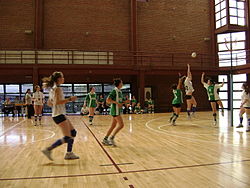This article needs additional citations for verification. Please help improve this article by adding citations to reliable sources. Unsourced material may be challenged and removed.Find sources: "Cestoball" – news · newspapers · books · scholar · JSTOR (June 2019) (Learn how and when to remove this message)
.mw-parser-output .hidden-begin{box-sizing:border-box;width:100%;padding:5px;border:none;font-size:95%}.mw-parser-output .hidden-title{font-weight:bold;line-height:1.6;text-align:left}.mw-parser-output .hidden-content{text-align:left}@media all and (max-width:500px){.mw-parser-output .hidden-begin{width:auto!important;clear:none!important;float:none!important))You can help expand this article with text translated from the corresponding article in Spanish. (December 2011) Click [show] for important translation instructions.
View a machine-translated version of the Spanish article.
Machine translation, like DeepL or Google Translate, is a useful starting point for translations, but translators must revise errors as necessary and confirm that the translation is accurate, rather than simply copy-pasting machine-translated text into the English Wikipedia.
Consider adding a topic to this template: there are already 938 articles in the main category, and specifying|topic= will aid in categorization.
Do not translate text that appears unreliable or low-quality. If possible, verify the text with references provided in the foreign-language article.
You must provide copyright attribution in the edit summary accompanying your translation by providing an interlanguage link to the source of your translation. A model attribution edit summary is Content in this edit is translated from the existing Spanish Wikipedia article at [[:es:Cestoball]]; see its history for attribution.
You may also add the template ((Translated|es|Cestoball)) to the talk page.
For more guidance, see Wikipedia:Translation.

Cestoball is a sport created in Argentina[1] in 1897. During the conference in Buenos Aires and Santa Rosa in 1986, the sport changed the name to Cestoball with the purpose of making the old Argentine sport called 'pelota al cesto' (ball to basket) more dynamic and to bring its rules into closer harmony with korfball and netball.[2]